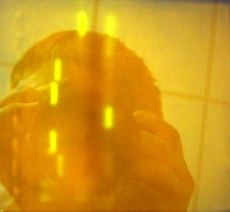Team:Cambridge/Protocols/Gel Electrophoresis
From 2011.igem.org
(Difference between revisions)
(→Theory) |
|||
| Line 7: | Line 7: | ||
===Theory=== | ===Theory=== | ||
| - | + | [[File:CAM ELECTRO.JPG | thumb | 200px | right | Our first Gel Electrophoresis]] | |
DNA is negatively charged due to the phosphate ions in its backbone. Hence, when an electric field is applied across an electrolyte such as agarose gel the DNA fragments tend to move towards the cathode. The viscosity of the agarose gel presents a resistance against movement of the molecule that scales with surface area (and hence DNA strand length). The smaller the fragment, the less resistance it experiences from the surrounding gel, and hence the further it moves in a given time. A 'ladder' scale can be created, which is used to calibrate the distance moved with the DNA strand size. | DNA is negatively charged due to the phosphate ions in its backbone. Hence, when an electric field is applied across an electrolyte such as agarose gel the DNA fragments tend to move towards the cathode. The viscosity of the agarose gel presents a resistance against movement of the molecule that scales with surface area (and hence DNA strand length). The smaller the fragment, the less resistance it experiences from the surrounding gel, and hence the further it moves in a given time. A 'ladder' scale can be created, which is used to calibrate the distance moved with the DNA strand size. | ||
Revision as of 08:58, 11 July 2011
Loading...
Gel Electrophoresis
A method to separate DNA strands of different lengths.
Theory
DNA is negatively charged due to the phosphate ions in its backbone. Hence, when an electric field is applied across an electrolyte such as agarose gel the DNA fragments tend to move towards the cathode. The viscosity of the agarose gel presents a resistance against movement of the molecule that scales with surface area (and hence DNA strand length). The smaller the fragment, the less resistance it experiences from the surrounding gel, and hence the further it moves in a given time. A 'ladder' scale can be created, which is used to calibrate the distance moved with the DNA strand size.
Practice
Gel preparation:
- For 1% agarose gel (say 200ml), add 2g of agarose powder to 200 ml of 1X TAE buffer (obtained by diluting 10X TAE stock buffer with water). The shorter the DNA strand lengths, the more concentrated the gel should be.
- Heat the mixture in the microwave until the powder has completely dissolved.
- Transfer the solution into a disposable container.
- Gel stains should be added when the agarose becomes cool enough to touch. For SYBR Safe gel, add ??????
Electrophoresis setting:
- Ensure that the electrophoresis chamber is clean and dry, and tape the sides so that it is watertight. Slot in the comb.
- Pipette a small amount of the tepid gel mixture around the edges of the taped regions to seal the chamber.
- Add the remaining gel solution to the chamber, and wait for the gel to set. The cool gel can then be removed from the chamber.
- Fill the electrophoresis apparatus half-full with 1X TAE buffer solution (for good electrical contact) and place the set gel in the buffer. Ensure that there are no air bubbles (particularly in the wells created by the comb).
- Add the ladder solution to the first well, and the other mixtures to be separated to the other wells. A ?????? dye may be added to the mixtures.
- Connect the electrodes to the apparatus (the right way round!). Set DC voltage at 80V (with current at approximately 3 mA) and run for 30--60 minutes (or until the DNA has separated sufficiently).
Safety
- SYBR safe dye is dangerous to work with; everything that could have come into contact with it needs to be autoclaved, including gloves (which must be worn at all times during the whole procedure).
- Liquids heated in the microwave can be superheated; a fluid that does not seem to be boiling when taken out of the microwave can boil violently when swirled. Avoid this by removing the solution from the microwave intermittently and swirling at arms length.
 "
"

